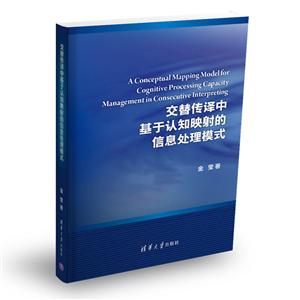扫一扫
关注中图网
官方微博
本类五星书更多>
-
>
鲍勃·迪伦诗歌集:1961-2012:典藏版
-
>
双城记-英文版
-
>
四级词汇词根+联想记忆法:乱序版
-
>
The secret garden
-
>
哈克贝利.费恩历险记/床头灯英语.2000词读物(英汉对照)
-
>
10000德语分类词汇联想记忆
-
>
英语词汇全书
交替传译中基于认知映射的信息处理模式 版权信息
- ISBN:9787302460503
- 条形码:9787302460503 ; 978-7-302-46050-3
- 装帧:一般胶版纸
- 册数:暂无
- 重量:暂无
- 所属分类:>
交替传译中基于认知映射的信息处理模式 本书特色
本书旨在提高交传口译质量,针对口译过程中普遍存在的认知负荷影响口译质量的现象,从认知语言学的角度分析,通过实证研究,构建认知信息处理能力工作模式,提高口译员的记忆力和精力分配的合理有效性。
交替传译中基于认知映射的信息处理模式 内容简介
本书旨在提高交传口译质量,针对口译过程中普遍存在的认知负荷影响口译质量的现象,从认知语言学的角度分析,通过实证研究,构建认知信息处理能力工作模式,提高口译员的记忆力和精力分配的合理有效性。
交替传译中基于认知映射的信息处理模式 目录
Acknowledgements i
Preface iii
List of Abbreviations vii
Chapter One Introduction 1
1.1 Background of Interpreting in China 3
1.1.1 An Overview of the Market 3
1.1.2 Interpreter Training in China 5
1.1.3 Interpreting Research at Different
Developmental
Stages 12
1.2 The Position of This Study 15
1.3 Research Scope 17
1.4 Research Question and Hypothesis 18
1.5 Research Methodology 20
1.6 The Outline of the Study 22
Chapter Two On Quality and Competence in
Consecutive
Interpreting 24
2.1 A Typology of Interpreting Modes 26
2.1.1 Categorization 27
2.1.2 Consecutive Interpreting 30
2.2 The Nature of Interpreting 34
2.2.1 The Process-oriented Approach 35
2.2.2 The Product-oriented Approach 38
2.3 Interpreting Quality 40
2.3.1 Defining Interpreting Quality 42
2.3.2 Quality Criteria 43
A Conceptual Mapping Model for Cognitive
Processing Capacity
Management in Consecutive Interpreting
2.4 Interpreter Competence 54
2.4.1 Terminological Clarification 56
2.4.2 The Componential Approach to
Interpreter Competence 58
2.5 Summary 63
Chapter Three Cognitive Overload and
Cognitive Processing
Capacity Management in Consecutive
Interpreting 64
3.1 Cognitive Problems as a Major Challenge
to Interpreting
Quality 65
3.2 Review of Gile’s (1995) Effort Model
for Consecutive
Interpreting: Memory and Attention 68
3.3 Cognitive Processing Capacity
Management (CPCM) 71
3.3.1 Memory Operations 72
3.3.2 Attention Allocation 74
3.4 Cognitive Overload in Consecutive
Interpreting 76
3.4.1 Definition of Cognitive Overload 77
3.4.2 Causes of Cognitive Overload 77
3.5 Summary 82
Chapter Four The Conceptual Mapping Model
for
Consecutive Interpreting 83
4.1 The Aims of the Model 83
4.2 The Theoretical Framework for the Model
85
4.2.1 Scene-frame Theory (Fillmore 1977) 85
4.2.2 Relevance Theory (Sperber &
Wilson 1986) 87
4.3 Fundamental Concepts 92
4.3.1 Interpreting Processes: Interpreters’
Preparatory Work
and Their On-going Interpreting 92
4.3.2 Segmentation 93
4.3.3 Mind Mapping and Concept Mapping 95
4.4 Operation of the Model 99
Contents xi
4.4.1 Consecutive Interpreting as
Conceptual Mapping 99
4.4.2 Operational Constructs: Concept Units
and Information
Units 107
4.4.3 The Working Strategies 112
4.5 Summary 115
Chapter Five An Experimental Study of the
Training Effects
of the Conceptual Mapping Model 117
5.1 Research Question, Hypotheses and Aims
118
5.1.1 Research Question 118
5.1.2 Hypotheses and Aims 119
5.2 Research Approach and Methods 121
5.3 Research Design 123
5.4 The Training Scheme 125
5.4.1 Learning Objectives 125
5.4.2 Teaching Methods: The Conceptual
Mapping Model 128
5.5 Research Participants 133
5.6 Data Collection Tools and Methods 134
5.6.1 Background Questionnaires 134
5.6.2 Testing Materials 135
5.7 Data Analysis Tools and Methods 137
5.7.1 Coding Schemes for the Two
Questionnaires 137
5.7.2 Evaluation of Interpreted Texts 140
5.8 Summary 146
Chapter Six Research Findings and
Discussion 147
6.1 Data Analysis of the Collected
Questionnaires 147
6.1.1 Pre-training Questionnaire (Q1) 148
6.1.2 Post-training Questionnaire (Q2) 152
6.1.3 Discussion Related to Sub-hypothesis
1 154
6.2 Data Analysis of the Interpreted Texts
155
6.2.1 Types of Errors 155
xii A Conceptual Mapping Model for
Cognitive Processing Capacity
Management in Consecutive Interpreting
6.2.2 The Experimental Group: Disscusion
Related to Subhyperthesis
2 161
6.2.3 The Control Group: Discussion Related
to Sub-hypothesis
3 162
6.3 Summary 163
Chapter Seven Teaching Implications of
Applying the
Conceptual Mapping Model 165
7.1 Cognitive Training in the Teaching of
Interpreting 165
7.1.1 The Necessity of Professional
Training 165
7.1.2 The Quality Criteria for Professional
Training 166
7.1.3 The Pedagogical Challenges to
Cognitive Training in the
Context of Interpreting 168
7.2 Implications of Applying the Conceptual
Mapping
Model 171
7.2.1 Different Thinking Patterns in Source
Text and Target
Text 172
7.2.2 The Important Role of Cognitive
Sub-competence 173
7.2.3 Learner Autonomy 173
7.3 A Model for Cognitive Training in
Consecutive Interpreting
175
7.3.1 Learning Environment: Authenticity
175
7.3.2 Free Translation and Literal
Translation 176
7.3.3 Note-taking and Conceptual Mapping
179
7.3.4 A Combination of Product- and
Process-oriented Feedback
181
7.3.5 Trainers’ Role in Learner Autonomy
184
7.4 Summary 186
Chapter Eight Directions for Future
Research 187
Appendix 189
Appendix A: The Analysis of the Test
Material 189
Contents xiii
Appendix B: Interview Questionnaire One
(Before the Cognitive
Training) 190
Appendix C: Interview Questionnaire Two
(After the Cognitive
Training) 191
Glossary 192
Bibliography 196
展开全部
书友推荐
- >
回忆爱玛侬
回忆爱玛侬
¥10.5¥32.8 - >
企鹅口袋书系列·伟大的思想20:论自然选择(英汉双语)
企鹅口袋书系列·伟大的思想20:论自然选择(英汉双语)
¥6.3¥14.0 - >
随园食单
随园食单
¥20.6¥48.0 - >
莉莉和章鱼
莉莉和章鱼
¥18.1¥42.0 - >
自卑与超越
自卑与超越
¥13.5¥39.8 - >
罗曼·罗兰读书随笔-精装
罗曼·罗兰读书随笔-精装
¥40.6¥58.0 - >
姑妈的宝刀
姑妈的宝刀
¥11.4¥30.0 - >
我从未如此眷恋人间
我从未如此眷恋人间
¥16.4¥49.8
本类畅销
-
2022图书×抽奖盲袋
¥9.9¥25 -
2023读书月阅读盲盒——天黑,闭眼,刀谁?
¥42.3¥158 -
2022读者节纪念徽章-三星会员专属
¥45¥45.6 -
2023读书月阅读盲盒——我什么场面没见过?
¥42.3¥158 -
2023读书月阅读盲盒——去码头整点什么薯条?
¥42.3¥158















